cont....
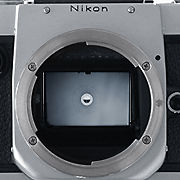 |
In addition, by a careful selection of the mirror's axis of rotation, Nikon has made the F2 camera's mirror 2mm longer than that of the Nikon F, eliminating image cutoff in the viewfinder even with super-telephoto lenses having focal lengths of over 880mm. |
The walls of the mirror box have a light-absorbing matte paint finish to minimize reflections. Moreover, the parts that cause reflection inside the box have beer reduced and light baffles added.
Shutter Release Button
The shutter release button also plays an important part in the picture taking process than most people would realize, for it is also used to govern the exact moment of exposure. Further, it has a dual function of providing Shutter Release Lock / Time Xposure function (via "T" setting at the fingerguard ring) while the Nikon designed a threaded shutter release button with finger guard which would accepts some dedicated soft shutter releases for more responsive handling.
 |
The fingerguard around the shutter release button serves as a safety lock against accidental shutter release and a control device for time exposures. Turning the fingerguard to "L" locks the shutter, while the "T" setting (with the speed dial adjusted to "B") prepares the camera for time exposures. When releasing the shutter except at "T" setting, the fingerguard is turned to the center position. For time exposure, set the shutter speed dial at "B," turn the T-L fingerguard to "T" and release the shutter. The shutter remains open until the fingerguard is returned to its neutral position. |
I would believe Nikon has paid a lot of attention to details in the Nikon F2, a great deal of testing has also providing just the right 'feel' to make Nikon so famous in its handling.
 |
Generally, other older Nikon camera models often exhibit such a distinctive feel which is heavily lacking in many of the modern Nikon autofocus SLR models. Although that could be a very personal assesment, probably I am getting too aged to appreciate modern ergonomic! |
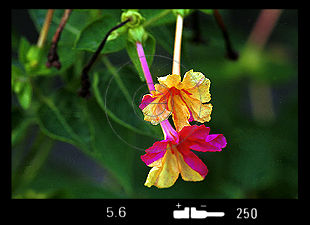 |
<<< ---- Even at handheld, steady hands and good habit of releasing the shutter release button is one of the essential elements to achieve good sharp pictures.... |
Self-Timer Operation
The self-timer permits delayed exposures of up to 10 seconds. Marked with numerals
2, 4, 6, 8 and 10. it sets the shutter for a delay of the number of seconds desired.
It can also be used for obtaining extra-slow shutter speeds of 2 to 10 seconds. If
you know how to make good use of the various preset timing available, it can also
be acted as a built-in Intervalometer.
 |
 |
To do this, cock the shutter, set the shutter speed dial at "B," turn the T-L fingerguard to the "T" position,.adjust the self-timer to the desired shutter speed setting, and press the shutter release button. The shutter will remain open for the preset duration and then close automatically. |
Film Transport - Smooth, precise Film advance and quick rewinding
For a mechanical camera, the film transport mechanism has always been given a lot of priority and attention in design. This is because in order to ensure the film travels smoothly through the camera, cassette after cassette, is no simple matter. You also need to make sure the film is held flat and precisely in the film plane, while ensuring that there are no rough edges to cut or scratch the delicate emulsion surface as it moves across the film guide rails in traveling from one exposure to another.
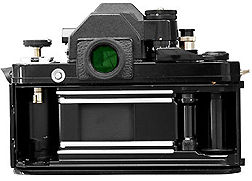 |
You also have to ensure guide rails in the camera are finely polished, shafts ground and centered, bearings fashioned from precision ball races or Teflon, gears meshed with Swiss watch making accuracy. The film advance lever provides sequential action of winds the film, cocks the shutter and operates the frame counter. |
One area where most professionals would demand for a short-stroke film advance lever action further compounds the problem; yet the F2 has one of the shortest - a mere 120° stroke.
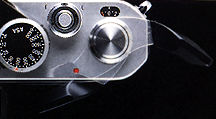 |
While Nikon has also been known for its excellence for firm, smooth film advance action in all their manual focus camera - The precision ball bearings and seflon bushings make possible smooth film advancing in a single 120° stroke or series of shorter strokes. |
The F2 is one of the very
few cameras that can take the continual pounding of a motor drive running at up to
five frames per second' - A feat that any standard production F2 can handle
with ease, as they are all built rugged enough from the start to take a motor drive
straight off-the-shelf.
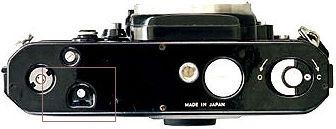 |
The F2's film advance mechanism is designed to avoid against accidental double exposures, yet can easily be overridden to provide for special effects and deliberate multiple exposures even when the motor drive is attached and running - an exclusive feature found only in some most of the Nikon camera/Motor drive combination introduced after 1977. |
Unlike the Nikon F or even Nikkormat bodies, multiple exposures operation with F2 has greatly improved to provide a new level of operational comfort. It was operated just by ensuring film advance lever is stroked while the rewind button on the camera base plate is held down, the shutter will be cocked without advancing the film. With a motor drive, you can exposed unlimited number of multiple exposures on a single frame* . The function has enabled many creative applications in such form where only make possible with Nikon camera for quite sometime.
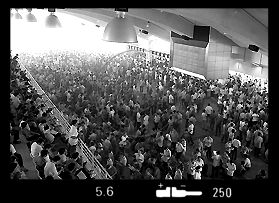 |
<<<< ----Betting Crowd, Turf Club (44K Jpeg File) Copyright © images 2000. Yang Zi Xiong ® A local freelance photographer. |
| Previous | NEXT | 5/10 Frame Counter, Awesome Firepower, Reflex Viewing Mechanism, synch adjustment, Film Back
| History & Background | Semi-FAQ | Various Features and Functions - 6 Parts |
System Accessories: Motor Drives / Prisms / Screens / Macro / Film Backs / Flash Other Accessories: DS-1 / DS-2 / DS-12 / eyepiece / DH-1 / cases / Cable releases / Miscellaneous
| Message Board | for
your favourite Nikon
F2 Series SLR model(s)
| Message Board | for your Nikon Optics in a shared environment
| Message Board | Specifically for Dispose or Looking for Nikon/Nikkor Photographic
Equipment
| Back | to Main Index Page of Nikon F2 Series SLR models
| Back |
Main Index Page of Pictorial History of Nikon SLRs
 |
The Eyes of Nikon:- |
Fisheye-Nikkor Lenses - Circular | Full Frame | Ultrawides Lenses - 13mm15mm18mm20mm | Wideangle Lenses - 24mm28mm35mm |
Standard Lenses - 45mm 50mm 58mm | Telephoto Lenses - 85mm105mm135mm180mm & 200mm |
Super-Telephoto Lenses - 300mm 400mm 500mm 600mm 800mm 1200mm |
Special Application lenses:
Micro-Nikkor Lenses - 50mm~55mm -60mm 85mm -105mm 200mm Micro-Zoom 70-180mm
Perspective Control (PC) - 28mm 35mm PC-Micro 85mm
Dedicated Lenses for Nikon F3AF: AF 80mm f/2.8 | AF 200mm f/3.5 EDIF
Depth of Field Control (DC): 105mm 135mm
Medical Nikkor: 120mm 200mm
Reflex-Nikkor Lenses - 500mm 1000mm 2000mm
Others: Noct Nikkor | OP-Nikkor | UV Nikkor 55mm 105mm | Focusing Units | Bellows-Nikkor 105mm 135mm
Nikon Series E Lenses: 28mm35mm50mm100mm135mm | E-Series Zoom lenses: 36~72mm75~150mm70~210mm
MF Zoom-Nikkor Lenses: 25~50mm | 28~45mm | 28~50mm | 28~85mm | 35~70mm | 36~72mm E | 35~85mm | 35~105mm | 35~135mm |
35~200mm | 43~86mm | 50~135mm | 50~300mm | 70~210mm E | 75~150mm E | 80~200mm | 85~250mm |
100~300mm | 180~600mm | 200~400mm | 200~600mm | 360~1200mm | 1200~1700mm
Tele-Converters: TC-1 | TC-2 | TC-200 | TC-201 | TC-300 | TC-301 | TC-14 | TC-14A | TC-14B | TC-14C | TC-14E | TC-16 | TC-16A | TC-20E
![]()
Nikon F
| Nikon F2 |
Nikon
F3
| Nikon F4 |
Nikon
F5
| Nikon F6 |
Nikkormat / Nikomat |
Nikon FM
| Nikon FE/ FA | Nikon EM/FG/FG20 | Nikon Digital SLRs | Nikon - Other models
MIR Supports for Photographic Community: Various Message Boards/Community
Forums
Nikon
F-series|
Nikon
F2-series|
Nikon
F3-series|
Nikon F4-series| Nikon
F5-series|Nikkormat/Nikomat-series
Nikon FM-series|Nikon
FE-series|Nikon
FA|Nikon
Digital
SLR
series|Various
Nikon
Models|Nikkor
Optic
-shared
Others:- Free Trade Zone - Photography| Free Trade Zone - Business Community |Free To Zouk - Photographic Community
Apple's Mac Public Community Message Board | Windows based PC &
Apple/Mac
Public Community Trade Exchange Centre
Recommended links to understand
more technical details related to the Nikkor F-mount and production Serial Number:
http://rick_oleson.tripod.com/index-153.html by: my friend, Rick Oleson
http://www.zi.ku.dk/personal/lhhansen/photo/fmount.htm by: Hansen, Lars Holst
http://www.mir.com.my/rb/photography/hardwares/nikonfmount/lens2.htm
http://www.photosynthesis.co.nz/nikon/serialno.html
About this photographic site.
HOME - Photography in Malaysia |
Copyright © 2000. leofoo ®. MIR Web Development Team.
In
memory of my friend Com.
Augusto Staut,
Brazil, 1971-2000.
Credit: Chuck Hester, US for his patience, encouragement
and help to setup the various content in this site; Robert Johnson for some of his original
images on the F2H-MD appeared in this site; my ex-staff, KiaSu for his superb
3-D logo appeared in this Nikon F2 site; Marc Vorgers from Holland who
generously provide me with some of his images of F2AS; MCLau®, who has so much time with me to
re-edit the content in this site and not to mention buying a Nikon Coolpix 990 just
for this site. Keat Photo,
Kuala Lumpur for providing
their Nikon F2A to take some images for this site; again, Mr Edward Ngoh the
great camera collector who provides us his collection of F2AS with MD-2; hawkeye.photographic.com
for their images on the Speed Magny film backs; Sean Cranor for his image
on Nikon F2 25th Anniversary Model; Ted Wengelaar®, Holland for his continuous
flow of input on some of the early Nikon bodies; CYLeow ® , photo editor of the Star
newspaper, Malaysia for some of his images used in this site. Ms Rissa Chan, Sales manager from
Shriro Malaysia who has helped to provide some of the very useful input. HiuraShinsaku®,
Nikomat ML, Japan for some of his images on various F2 models; my staff, Wati, Maisa, Mai and my nephew, EEWyn®, who volunteered and helping me
did so many of the film scanning works. Contributing photographers or resellers:
Jen Siow, Foo KokKin, Arthur Teng, Mark Fallander, John
Ishii, Ed Hassel, YoonKi Kim, Jean-Louis, M.Dugentas (Dell Corner.com.), Mr "Arsenall" and a few images mailed
in from surfers with no appropriate reference to their origin. Dedicated to KU Yeo, just to express our mutual regrets over the outcome of
a recent corporate event. Made with a PowerMac, broadcast with a Redhat Linux powered server.
![]()
![]()